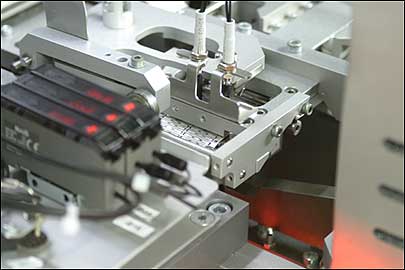A team of European companies says it has succeeded in using rotary screen technology to print fully functioning antennas for UHF radio frequency identification tags.
The group included printing systems developer and supplier Stork Prints, which says that the antennas were created using a specially equipped rotary screen printer designed by Stork and special conductive ink developed by Spraylat. The printed antennas were incorporated in tens of thousands of RFID labels, and some of those labels were tested and supplied to the German retailer Metro Group, where they performed well in supply chain applications.
“They can be read and written, at a distance of 3 meters plus. That is ideal for the scanning of pallets in the intended warehousing situation,” says Thorsten Wischnewski, head of the RFID-technology group at label manufacturer RAKO Security-Label, based in Witzhave, Germany. RAKO commissioned the printing of the antennas, assembled antennas and chips to make the tags, converted them into labels and tested their performance as part of its efforts to invest in developing new high-speed tag-production and label-converting methods.
“A lot of things came together to make the trial a breakthrough and a success: the characteristics of the ink and those of our screen material, plus RAKO’s antenna knowledge,” says Ger Roza, sales representative from Stork Prints, which is based in Boxmeer, Netherlands.
The specially designed ink used to make the 150-by-25-mm dipole antennas contained electrically conductive particles less than 5 microns in size, which meant they could pass through the screen used in printing, easily enabling the precise printing needed to create the antennas.
“With the new mesh design, we can control exactly the amount of ink that is deposited, so you use only what you need without wastage. The ink, after all, is expensive. And these RotaMesh screens can be reused or reimaged up to 15 times,” says Roza, who adds a batch of 20,000 antennas was printed in just 30 minutes. RAKO then converted finished antennas into RFID labels by attaching a 2024-bit 868 MHz RFID microchip using a Mühlbauer “Pick and Place” Tag Module Assembler (TMA) machine.
Invented by Stork Prints in the 1960s as a way to print on textiles, rotary screen printing has since been used to print graphics on a range of materials, including wallpaper and PVC flooring as well as print circuits for electrical components. Now, Stork says, RFID antennas can be printed using Stork’s specially developed RotaMesh screen combined with the special conductive ink. Made of pure nickel and welded, the screen has a unique design that makes it firm, stable and able to run constantly at a high speed and be used to quickly produce RFID antennas, according to Stork.
However, says Roza, some adjustments would have to be made to the printing process in order to dry the antennas. Most rotary screen printing uses ink that requires UV lamps to dry, but the conductive inks used to print antennas would require hot-air dryers instead. Even so, for smaller quantities of antennas, rotary screen printing would still provide a more cost-effective production method than the etching process that is currently used, according to Stork.
“The etching process is only economical with a large number of antennas and usually requires quantities of 500,000 for a production run. But there are a lot of niche markets in RFID where smaller numbers of tags, say, 20,000 to 30,000, are all that is required,” Roza says.
A number of other companies have been developing inks and printing methods in an attempt to find a way to print low-cost RFID antennas and, eventually, complete RFID tags (see Making Inks for Printable Tags, Developing Tomorrow’s Tags and Start the Presses).


